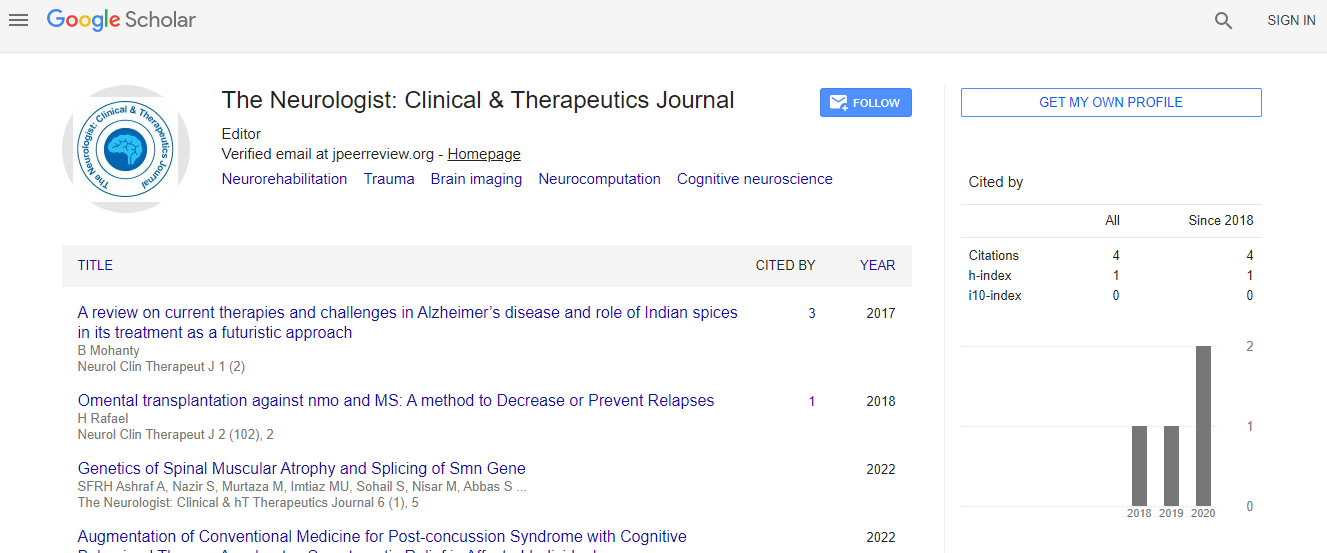Neurology Congress 2019 & Vascular Dementia Congress 2019: Diagnosing leprosy at its neuritic phas - Nihar Ranjan Haldar - Nobel Medical College Teaching Hospital
*Corresponding Author:
Copyright: © 2019 . This is an open-access article distributed under the terms of the Creative Commons Attribution License, which permits unrestricted use, distribution, and reproduction in any medium, provided the original author and source are credited.
Abstract
Leprosy is known to common people including medical practitioners as a disfiguring contagious disease. Patients suffering from leprosy usually have ulcers, in the extremities loss of fingers, nasal tips and ear lobule if not treated. They go to dermatologist or laporalogists. Pathophysiology says it is an illness which affects nervous system i.e. peripheral sensory and motor nerves. Ulceration and disfiguring are secondary to trauma and later involvement of skin. It is a very common infective illness of nervous system if taken worldwide statistics (>200,000 new case per year). It is neglected by neurologist when patients present initially with neurological symptoms, it becomes obvious when skin is affected. Hypertrophic neuropathy is a common type of initial association which can be detected when first they present with minor neurological symptoms. Ultrasonography of nerves as a routine investigation tool is neglected in most of the places which could have identified the disease. Assessment of hypertrophy or other pathologic changes by ultrasonic examination was practiced by us to detect enlargement of any kind. Leprosy is a chronic, infectious peripheral neuropathy caused by Mycobacterium leprae. The different clinical presentations are determined by the quality of the host's immune response. Early diagnosis and multi-drug therapy are the most important steps in preventing deformities and disabilities. Thus, early recognition of the clinical presentation of leprosy is essential. Mononeurites, multiple mononeurites (MM), polyneuritis (MM overlap) are the most frequent. Frequent anesthetic skin lesions are absent in pure neuritic form. Isolated nerve involvement is common, including cranial nerve. Arthritic presentation is occasionally seen, mistakenly diagnosed as rheumatoid arthritis. Attention should be paid to autonomic dysfunctions in leprosy. There are clinical presentations with severe neuropathic pain - painful small fiber neuropathy. Leprosy, a chronic infectious disease caused by Mycobacterium leprae, identified by G. H. A. Hansen in 1873, is one of the most common treatable peripheral neuropathy in the world. Leprosy causes a ‘mononeuritis multiplex’ of immunological origin that results in autonomic, sensory and motor neuropathy1. The skin, the peripheral nerves, the nasal mucosa, eyes, and the reticulum-endothelial system are the preferred target sites for this infection. The clinical and pathological manifestations are determined by the natural resistance of the host to invasion of M. Leprae. It still remains a stigmatizing disease. Leprosy can be effectively treated with multidrug therapy (MDT) before disability appears. The early diagnosis of leprosy often leads to a less amount of disabilities. This review has the objective to call attention for the clinical presentations of leprosy neuropathy in clinical practice.
Materials & Methods:
We report 1200 consecutive cases, studied in patients from Nepal, India, Bhutan and Bangladesh. Patients were from neurology and dermatology clinics. High resolution Ultrasonography machine and 12 MHz linear transducer were used for the investigation. Hypoechoic nerves were subjected to aspiration cytology for detecting acid fast bacilli. Duration of study was from 2005 to 2018.
Results:
From a total of 1200 cases, 75% had thickened nerves, 20% had doubtfully thickened nerves, 11% normal nerves, 3% cases showed nodularity and nerve abscess was seen in 2% cases; 43% had hypoechoic nerves; Aspiration cytology was done in 3323 hypoechoic nerves, of which 27% had granulomatous inflammation, 8% were AFB positive and 20% had no yield (Figures rounded).
Conclusion:
It is true that all leprosy patients to start with are pure neuritic leprosy with sensory or motor symptoms. Early diagnosis is very important and obvious that doing ultrasonography of nerves is a very useful method to identify certain common group of peripheral nerves in medical practice, especially in tropical countries. Further development and practice in this regard needs to be done using high resolution ultrasonography machine and expert personnel generation. Awareness among general physician and neurophysician are very much needed for early identification of the disease. PNL is not a synonym of pure neural leprosy, as this condition may include a generalized immune response and also a skin involvement, documented by molecular findings. Immunological, molecular, and neurophysiological tools must be implemented for diagnosing primary neural leprosy to achieve effective treatment and reduction of its resultant disabilities that still represent a public health problem in several developing nations. Finally, we propose a algorithm and recommendations for the diagnosis of primary neural leprosy based on the combination of the three clinical-laboratorial tools.

 Spanish
Spanish  Chinese
Chinese  Russian
Russian  German
German  French
French  Japanese
Japanese  Portuguese
Portuguese  Hindi
Hindi 